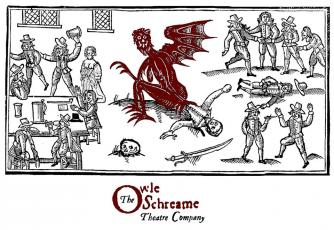
November 25, 2013, by Peter Kirwan
Honoria and Mammon (The Owle Schreame) @ St Giles-in-the-Fields Church
James Shirley’s Honoria and Mammon appears never to have been performed in the three hundred and fifty years since it was printed during the Interregnum, and its world premiere in the church where Shirley is buried, as part of The Owle Schreame’s ‘Cannibal Valour‘ season, was therefore doubly significant. Playing it uncut, Shirley’s emblematic moral comedy proved to have theatrical legs that, while not keeping pace with the company’s Bussy D’Ambois, allowed it at least a fair run.
That’s not to say it couldn’t have used some cutting. Despite the best efforts of the cast, the comic drunken soldiers of the second half were one complication too many and added little to the amusement of the piece, and the shifting allegiances of the various suitors to Honoria and Mammon were less interesting in the intricate details than in their blunter effects. The machinations of Phantasm were also somewhat obscure, and the performer was one of the more difficult to hear among the echoing acoustics of the beautiful church: his true demonic nature in particular did not obviously manifest. The play’s multiple objects of satire render it complex and somewhat baggy, and even a company this versatile could perhaps not hope to make every element clear.
At its core, however, was a deceptively straightforward wooing comedy between a range of stock figures. The choice not to emphasise the morality aspect by exaggerating the ideas represented by the characters kept the wooing more straightforward, and the Ladies Honoria and Mammon themselves were more people than the ideas of honour and riches they figured. Mammon’s shallower streak saw her lead wooers on from a throne-like chair, holding out her hand to one while smiling in the face of the other, but not until the end was she suitably chastised. Honoria, by contrast, spent more time standing, but did not disguise her frustration at the combatting suitors or her distress as she tested Alworth.
It was the suitors who emerged as the strongest set of individuals, particularly Fulbank and Maslin in a hugely entertaining duel. Goaded by Phantasm, the two finally drew swords on one another before cowardly agreeing to exchange only the lightest of blows. The light tap from Fulbank’s sword on Maslin’s arm caused his entire hand and rapier to drop off, to excellent comic effect, and the ongoing ridicule of Maslin – first appearing in exaggerated robes, and later appearing stripped right down to an exposed patch at the back of his breeches – was the strongest comic through line. Fulbank, meanwhile, channelled Mark Rylance in an effective dithering portrayal of pretentious foppery.
The mirror duel between the arrogant Conquest and the simpering Alamode was also entertaining, Conquest laughing and then finally pitying the courtier as he struggled to hold up his sword and quailed under the Colonel’s blows. Conquest was a particularly fascinating character, final victor and arbiter in the wooing games despite initially being an aggressive and problematic figure. The politics of might winning out are particularly interesting for a play written during the Interregnum. Yet the play’s sympathies remained clearly with Alworth, dressed in black and a calm presence throughout. The actor found humour in the long-suffering character, particularly during Honoria’s cruel trial, the severity of which beggared belief as she suddenly realised she’d been lying to him all along about her feelings. Alworth’s swoon felt, at that point, like a final comic contrivance in a rather silly game.
Eventually the play’s catalyst emerged, in the person of director Brice Stratford as the lawyer Traverse. Besieged by a chorus holding out writs and served by a hunchbacked lackey, this Dickensian figure trumped the other suitors, took both Honoria and Mammon captive and provided a clear villain for the piece, smooth-talking and amoral. The machinations of his plot were somewhat unclear – quite what the little sexual trysts in the pulpit said about the status of his victims in particular – but the main purpose, his dethroning and humbling at the hands of Conquest, gave him a clear function.
What emerged from the performance was a sense of the chaos that ensues as the various echelons of society fight for precedence. Shirley’s dramaturgy allowed for a shifting number of comic controllers – the agile and sardonic Phantasm, the cocksure and flourishing Traverse, the smug and powerful Conquest, the blunt Maslin, the triumphant Fulbank, all at least once found themselves running the show. The quick turns of the plot were handled dexterously by the company, but I found myself wishing that the play’s heart, Honoria and Alworth, had more space to develop and offset the busy satire elsewhere.
While the play itself has its issues, the game cast and excellent musicians kept it moving at a merry lick. An interval performance of the filthy ballad ‘When ere my dame a hedging goes’ was a particular highlight, but the inventive staging throughout (actors hiding in the pews, energetic sword fights, a full-scale closing jig) kept the play lively even when plot threatened to weigh it down. The simplicity of the key images – including, finally, Traverse and then Conquest holding a pistol square at the beleaguered and defiant Alworth – stood out, recapturing something of the emblematic significance of the characters and ultimately building towards the happy, moralistic conclusion, accented by the antimasque-like appearance of the stripped Maslin.
Sadly, the evening’s scheduled performance of the company’s other premiere, Thomas Nabbes’s The Unfortunate Mother was cancelled owing to cast indisposition, so this concludes my coverage of Cannibal Valour. However, I can’t commend the endeavour enough. It’s a bold, stylish and intelligent experiment to dig into the real obscurities of Jacobean and Caroline drama that deserves to be seen by much larger audiences.
No comments yet, fill out a comment to be the first

Leave a Reply